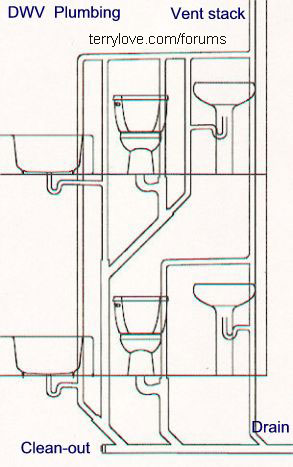I am remodeling the only bathroom in our 3 x 1, 980 sq. ft. home. It was built in 1943 and the original configuration still exists of the plumbing, but the materials have changed over time. Previous owners before me had made repairs, so the makeup is as follows:
Waste stack is 4" cast iron. The single vent is galvanized for the vertical portion, but PVC for the rest of it (both the vertical portion that goes to the basement as well as the horizontal leg to the vertical main vent. All PVC except the traps are 2". The traps are 1.5" currently. Note, for simplicity in my SketchUp animation, everything is either 2" or 3" so I could get it together quickly.
I am in VA, so IPC and no locality code deviations exist.
As you will see, the bathroom and the kitchen share a wall. Everything is sharing a wet vent in this setup, but one thing I know I will be changing is removing the sani-tee between the sink drains and installing a double wye, thus eliminating the horizontal drain/vent connection and running a new vent horizontally, then turn to tee into the existing vent so that it is above the flood level rim.
I also think the tub vent is too long before it reaches its vent. It is also too far below the joists, which I will fix. The one thing I want to try to avoid is getting in the attic to attach any venting if at all possible. I recently had my attic reblown and don't want to crush down any of the insulation, plus it is super tight up there and hard to work with.
One final note, there is a washer that is connected into the stand pipe in the basement and while it looks a bit rough, in my opinion, I actually haven't had any issues out of my system the entire 16 years we have lived here. No smells nor any backups or drainage issues. That being said, I do want to completely redo all of it except the last vent from behind the toilet through the roof. I am looking for some advice on what I should look out for, be aware of, anything that is no longer up to code, etc.
This animation is of the Sketchup model I made of my bathroom and kitchen. It is all accurate within its measurements (as in yes, my studs really are that unevenly spaced in the batrhoom walls as are the joists and yes the toilet bend really is that tight against that one joist. The animation focuses on several view angles, so if you watch it all, it will move to give a good overview. Thanks!
Waste stack is 4" cast iron. The single vent is galvanized for the vertical portion, but PVC for the rest of it (both the vertical portion that goes to the basement as well as the horizontal leg to the vertical main vent. All PVC except the traps are 2". The traps are 1.5" currently. Note, for simplicity in my SketchUp animation, everything is either 2" or 3" so I could get it together quickly.
I am in VA, so IPC and no locality code deviations exist.
As you will see, the bathroom and the kitchen share a wall. Everything is sharing a wet vent in this setup, but one thing I know I will be changing is removing the sani-tee between the sink drains and installing a double wye, thus eliminating the horizontal drain/vent connection and running a new vent horizontally, then turn to tee into the existing vent so that it is above the flood level rim.
I also think the tub vent is too long before it reaches its vent. It is also too far below the joists, which I will fix. The one thing I want to try to avoid is getting in the attic to attach any venting if at all possible. I recently had my attic reblown and don't want to crush down any of the insulation, plus it is super tight up there and hard to work with.
One final note, there is a washer that is connected into the stand pipe in the basement and while it looks a bit rough, in my opinion, I actually haven't had any issues out of my system the entire 16 years we have lived here. No smells nor any backups or drainage issues. That being said, I do want to completely redo all of it except the last vent from behind the toilet through the roof. I am looking for some advice on what I should look out for, be aware of, anything that is no longer up to code, etc.
This animation is of the Sketchup model I made of my bathroom and kitchen. It is all accurate within its measurements (as in yes, my studs really are that unevenly spaced in the batrhoom walls as are the joists and yes the toilet bend really is that tight against that one joist. The animation focuses on several view angles, so if you watch it all, it will move to give a good overview. Thanks!



